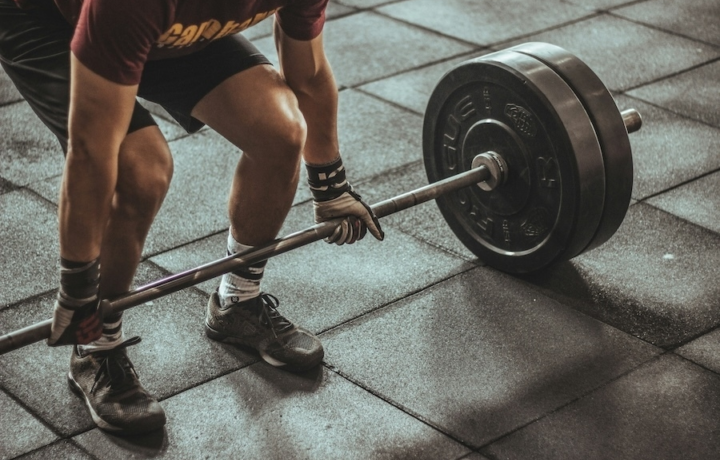Exercise
Stability Ball Leg Curl

Stability Ball Leg Curl
How to Perform
- Lie on your back with your legs extended and heels on the stability ball, arms at your sides with palms facing down.
- Engage your core by drawing your navel toward your spine and press your arms firmly into the floor for stability.
- Exhale as you bend your knees, rolling the ball toward your body by contracting your hamstrings and lifting your hips slightly off the floor.
- Continue pulling the ball inward until your feet are flat on the ball and your knees are bent at approximately 90 degrees, maintaining a neutral spine position.
- Hold the contracted position for a moment while keeping your glutes engaged and your hips elevated slightly off the ground.
- Inhale as you slowly straighten your legs, controlling the ball's movement away from your body without letting your hips drop.
- Extend your legs completely while maintaining tension in your hamstrings and keeping your lower back pressed into the floor.
- Perform the prescribed number of repetitions while maintaining a controlled tempo throughout the entire movement.
Important information
- Keep your head, shoulders, and upper back in contact with the floor throughout the entire exercise to protect your neck and spine.
- Avoid lifting your hips too high off the floor, as this shifts emphasis away from the hamstrings and can strain your lower back.
- If you find the exercise too challenging, start with your knees bent at a 90-degree angle rather than fully extended.
- Focus on moving the ball with your hamstrings rather than pushing with your feet to maximize muscle engagement.

Stability Ball Leg Curl
Exercise Details
Primary Muscles
Muscle Groups
Mechanic
Risk Areas
Built for progress
Take the guesswork out of training
Create personalized AI-powered workout plans that evolve with you. Train smarter, track every rep and keep moving forward, one workout at a time.






The Stability ball Leg Curl stands as a versatile intermediate-level movement that powerfully targets the posterior chain, with primary emphasis on the hamstrings and glutes. This exercise has earned its place in both bodybuilding routines and rehabilitation programs, offering significant benefits without requiring complex equipment or excessive joint stress. When incorporated into a consistent training regimen, the Stability Ball Leg Curl contributes substantially to lower body strength development while promoting muscular balance between the quadriceps and hamstrings. This balance is crucial not only for aesthetic symmetry prized in bodybuilding circles but also for functional strength and injury prevention.
The stability challenge presented by the Stability ball engages additional stabilizer muscles throughout the core and hips, creating a more comprehensive lower body workout than many machine-based alternatives. For those recovering from certain lower back or knee injuries, this exercise can serve as an effective rehabilitation tool when performed under appropriate supervision. The reduced axial loading compared to traditional hamstring exercises like deadlifts makes it accessible to those working around specific limitations while still stimulating meaningful muscle activation and growth. Strength athletes find value in the Stability Ball Leg Curl as an accessory movement that addresses potential weak links in their posterior chain. The exercise creates significant time under tension for the hamstrings: a quality that promotes muscle hypertrophy when performed in moderate to high repetition ranges.
This focused attention on hamstring development pays dividends in improved athletic performance, from enhanced sprinting speed to greater stability in compound lifts. The adjustable difficulty based on ball position, leg extension, and execution speed: makes this exercise scalable as fitness levels improve. While seemingly simple, mastering the Stability Ball Leg Curl requires body awareness, control, and dedicated focus to maximize its benefits. When programmed appropriately within a comprehensive training plan, this exercise delivers remarkable results for hamstring development and posterior chain strength that translate to both aesthetic improvements and functional capacity.
FAQ - Stability Ball Leg Curl
The Stability Ball Leg Curl primarily targets the hamstrings and glutes while also engaging the calves and core stabilizers. Your lower back and hip stabilizers also work isometrically to maintain proper position throughout the movement.
For an easier version, keep the ball closer to your hips and perform partial range of motion curls. To increase difficulty, position the ball further from your body, extend your arms out to the sides rather than using them for support, or progress to single-leg variations.
The Stability Ball Leg Curl is generally considered lower-impact than loaded hamstring exercises like deadlifts, making it suitable for many rehabilitation programs. However, those with specific knee injuries or acute lower back pain should consult a physical therapist before attempting this movement.
The most common mistakes include rounding your lower back, rotating your hips instead of keeping them square, rushing through the movement, and not hinging properly at the hips. Focus on maintaining a neutral spine, moving with control, and keeping your standing knee slightly soft rather than locked.
For optimal hamstring development, incorporate Exercise Ball Leg Curls 1-2 times weekly with 3-4 sets of 10-15 repetitions. Allow 48-72 hours between hamstring-focused workouts for proper recovery, especially if you're also performing other posterior chain exercises like deadlifts or Romanian deadlifts.







